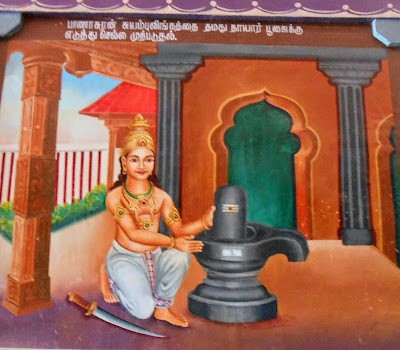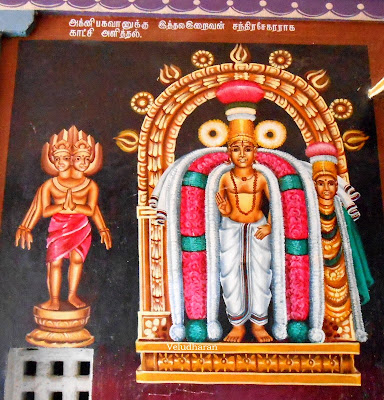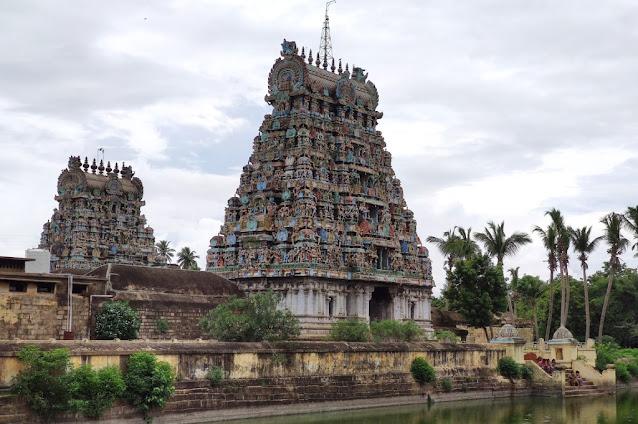- Agnipureeswarar Temple, located in Thirupugalur Village near Thirukannapuram in Thirumarugal Taluk, Nagapattinam District of Tamil Nadu, is the 192nd Devara Paadal Petra Shiva Sthalam and the 75th on the southern bank of the Kaveri River in Chozha Nadu.
- This revered Hindu temple is dedicated to Lord Shiva, with the presiding deity known by various names, including Agnipureeswarar, Agneeswarar, Konappiraan, Saranyapureeswarar, Punnagavana Nathar, and Pratyaksha Varadar.
- The divine mother is worshipped as Karundhar Kuzhali or Soolikambal.
- Thirupugalur is notable for being the birthplace of Muruga Nayanar, one of the 63 Nayanmars, and is also recognized as a Sathayam Nakshatra temple.
- This site holds special significance as a Vastu Parihara Sthalam, believed to be a place of spiritual remedy.
- The temple is one of the 44 Paadal Petra Sthalams where the three Nayanmars-Sambandar, Appar, and Sundarar-composed hymns in praise of Lord Shiva.
- Notably, Nayanmar Appar attained mukthi here and sang his final padhigam at this sacred site.
- Additionally, the Vardhamaneswar Shrine within the temple is honoured in the verses of Devaram by Sambandar, solidifying its status as a cherished place of worship.
HISTORY:
- Banasura, a member of the demon community and the son of the devoted Shiva worshipper Madhiniar, dedicated himself to facilitating his mother’s Shiva puja. In his quest, he sought out many swayambu Lingas. During one of his journeys to Tirupugalur, he discovered countless Lingas, but one particular swayambhu Linga was immovable.
- In his determination, Banasura dug a deep, expansive agazhi (moat) around the temple in an attempt to shift the Linga. However, despite his efforts, he could not budge it; the agazhi filled with water springing from the ground instead.
- Frustrated and desperate, he contemplated ending his life. At that moment, a celestial voice reassured him, saying, “I will make myself present for your mother’s Shiva puja.” In response, Lord Shiva, known as Konapiran, appeared before Madhiniar adorned with Punnai flowers.
- After the puja concluded, the Lord returned to Tirupugalur, fulfilling Banasura’s wish to support his mother’s devotion.
PURANIC SIGNIFICANCE1:
Agnipureeswarar:
As per legend, Agni, Varuna and Vayu had a heated argument about their greatness. Due to the heated argument, Agni got furious and disappeared completely. All the vedic rites, particularly the Yagna came to a standstill due to the absence of Agni. Agni came here and worshipped Lord Shiva. Lord Shiva in the form of Chandrasekara brought back Agni. Hence, Lord Shiva of this temple came to be called as Agnipureeswarar and the temple tank came to be called as Agni Theertham. This occasion is celebrated on the full moon day of Tamil month Vaikasi (May-June). In this temple. Also, the Sayarakshai Pooja takes place at this temple only after pooja for Agni.
Agni with physical body:
As per legend, Agni had no physical body, but Agni wished to have one. Hence, he sought the advice of Lord Brahma and Lord Vishnu. Both of them advised Agni to perform pooja to Lord Shiva at a place where Lord Shiva is seen with tilak. Agni found the form of Lord Shiva in this temple. He came here and performed prayers to Lord Shiva. Pleased with his prayers, Lord Shiva blessed him with a physical body. This is the only temple where Agni has a physical structure. He is seen with two heads, 7 hands, 3 legs, 7 Jwala and with 4 Korai teeth.
Kona Piran:
- Banasura, a mighty asura, once ruled over the three worlds. His influence was so strong and fierce that all the kings and even devas shuddered in front of him. His mother was an ardent devotee of Lord Shiva. She used to perform pooja with 108 Swayambhu Lingam in Kasi. To meet this requirement, the Asura took Lingas from various places. He had collected up to 107 Lingas. He came to Thirupugalur for his 108th Linga. He found several Lingas in this place and found a Swayambhu Linga meeting his requirements.
- He tried to uproot the Linga but could not move it. Hence, he dug a deep and vast Agazhi around this Linga and tried to move the Linga again. All his efforts in moving the Linga failed. In turn, the Agazhi he excavated was full of water springing from the ground. He decided to end his life in frustration. Pleased with his devotion and commitment to his mother, Lord Shiva is said to have turned slightly towards north (Kasi) and provided darshan to his mother.
- At that time, a divine voice from the sky informed him that the Linga would be available for his mother’s Pooja. Hence, Lord Shiva came to be called as Kona Piran (Konal means tilted in Tamil). The Agazhi he excavated came to be called as Bana Theertham. Later, Agni took bath in this Theertham and worshipped Lord Shiva here. Hence, it is also called as Agni Theertham.
Mukthi Sthalam of Appar:
- As per legend, Appar (Tirunavukkarasar) is said to have spent his last years here. He used to serve Lord Shiva in various Shiva temples by cleaning the grounds and paths to enable devotees to walk comfortably. He did this work using a tool called Uzhavaram. Thus, the work done by Appar came to be called as Uzhavara Pani. He served the Lord Shiva here by doing Uzhavara Pani during his last days. Appar repeatedly prayed to Lord Shiva requesting for salvation.
- Lord Shiva wanted to test the devotion of Appar. Lord Shiva put some valuable gems at the place where Appar was cleaning. Appar did not show any regard for the precious gems and threw them out along with other wastes. Then, Lord Shiva sent few celestial nymphs to entice him. However, Appar didn’t show any interest towards them. Lord Shiva was astonished to see the devotion of Appar towards him.
- Appar attained salvation (Mukthi) at the age of 81 on a Chithirai Sadayam star day. To commemorate this event, a grand festival is celebrated every year on this day called Appar festival. Appar festival begins 10 days before Chithirai Sadayam Star day in April-May. The events include his home coming from the Jains, the greatness of his Uzhavaram, dance of celestial nymphs and his merging with Lord Shiva. There is a separate shrine for Appar in this temple in memory of this episode.
Vasthu Parihara Sthalam:
- As per legend, Sundarar decided to provide Annadhanam for the devotees on Panguni Uthiram in Thiruvarur but he was short of funds. He informed his wife that he would visit Thirupugalur to worship Lord Shiva and wanted to get some money from him. He reached Thirupugalur in late evening and the temple was closed. Sundarar decided to stay outside the temple for the night and could worship Lord Shiva in the morning.
- He picked up a brick and placed his head on the brick and slept thinking of Lord Shiva. Lord Shiva appeared in his dreams and assured him that he would provide necessary money to carry out his noble cause. When he woke up, he was surprised to see the brick got turned into a gold bar. Sundarar was overwhelmed with joy and rendered 11 Pathigams in praise of Lord Shiva.
- He further requested Lord Shiva that Lord should bless all the devotees who visit here with issues relating to house construction. Thus, this temple is considered as Vastu Parihara Sthalam. People bring 3 bricks and after prayers, take them and install them on the Eesanya (North East), Agni (South East) and the proposed pooja room (North east, east or north are the preferred corners) so that the construction proceeds smoothly. Hence, Lord Shiva is also called as Vasthunathar.
Shrine of Saneeswarar along with Emperor Nala:
As per legend, Emperor Nala was under the influence of Lord Saneeswarar. He visited this temple, took bath in Bana Theertham and worshipped Lord Shiva for relief. After worshipping Lord Shiva, a divine voice informed him that he would be relieved from the influence of Lord Saneeswarar at Thirunallar. Hence, Lord Saneeswarar in this temple is considered as Anugraha Moorthy. There is a special west facing shrine for Lord Saneeswarar along with Emperor Nala in this temple. It is said that one must visit this temple first before visiting Thirunallar.
Mother Shrines located at a distance away from Sanctum:
- As per legend, a local king prayed to Lord Shiva of Raamanadeechuram for child boon. Raamanadeechuram is a Devara Padal Petra Sthalam situated close to Thirupugalur. He performed a Yagna to realise his wish. A divine voice informed him that he would be blessed with a girl child soon and this child would be an incarnation of Mother Parvathy herself. After a while, when the king went for hunting in the forest, he saw four young girls under a tree. He brought them to his palace and raised them as his own daughters.
- When they reached the marriageable age, the king prayed to Lord Shiva and requested Lord Shiva to marry them. As requested, Lord Shiva married them at four temples nearby namely Karundhar Kuzhali in Thirupugalur Agnipureeswarar Temple, Vanduvaar Kuzhali in Thirumarugal Rathnagiriswarar Temple, Sarivar Kuzhali in Raamanadeechuram and Vaaitha Thirukuzhal Nayaki in Thiruchengattangudi Uthrapathiswarar Temple.
- It is believed that these four Goddesses once helped a pregnant woman deliver her child. Hence, these goddesses are referred to by the common name Choolikambal. (Chool means pregnancy in Tamil). It is said that when the goddesses returned to the temple after this incident, they stayed at a distance away from the sanctum. Thus, the shrines of Parvathy at these temples are located at a distance from the sanctum to symbolically represent the above story.
Karundhar Kuzhali:
Once, a pregnant woman from a nearby village Polagam was under labour pain and was not able to find a doctor as the village was hit by severe floods. She prayed sincerely to Mother Parvathy for safe delivery. Pleased with her prayers, She attended her in the guise of a nurse and helped her in safe delivery. Hence, she came to be called as Karundhar Kuzhali. As a symbolic gesture of having played the role of a nurse, a white saree is presented to Ambal during the night pooja. People strongly believe that there would not be any infant or maternal mortality in this place.
Muruga Nayanar:
- Muruga Nayanar is a Nayanar saint, venerated in the Hindu sect of Shaivism. He is generally counted as the fifteenth in the list of 63 Nayanars. Traditional hagiographies like Periya Puranam (13th century CE) and Thiru Thondar Thogai (10th century CE) describe him as a great devotee of Lord Shiva. He is described to have lived an ascetic life, filled with austerity and selfless devotion to Shiva, spending his time in collecting flowers from woodlands and decorating the Shiva Lingam with garlands and coronets. Muruga Nayanar was born in a Brahmin family in Chola Nadu, now located in Nagapattinam District, Tamil Nadu.
- His daily routine was to leave home in the early morning and roam around the woodland to collect the colourful and fragrant flowers like lotus, champaka, jasmine, konrai etc. While plucking flowers he used to chant the Panchakshara mantra. He would get back home and tie up the flowers into beautiful garlands and coronets to adorn the Shiva Lingam (Vardhamaneeswarar) and his consort Parvati (Manonmani). He was in the habit of visiting the temple at least three times daily.
- Muruga Nayanar is described as a contemporary of other Nayanars like Sambandar, Appar, Sundarar, Thiruneelakandar and Thiruneelakanda Yaazhpaanar Nayanar. When Sambandar and Thirunavukkarasar, two of the most prominent Nayanars, visited the Thirupugalur temple, Muruga Nayanar warmly welcomed them and took them home. Spending time with them and listening to their hymns, Muruga Nayanar was elated. Sambandar appreciated Muruga Nayanar's devotion to Shiva and developed a thick friendship with him.
- Sambandar invited Muruga Nayanar to his wedding in Nallur Perumanam. After the wedding, Sambandar, his bride and other Shiva devotees went again to Nallur Perumanam temple of Lord Shiva. Sambandar prayed to Lord Shiva, seeking salvation and sang a hymn called Panchakshara Pathikam. Lord Shiva appeared before him and granted his wish. Then Sambandar, his bride and all the wedding guests, including Muruga Nayanar merged in the Light of Siva. The Tamil month Vaikasi, star Moolam (nakshatra) is observed as Muruga Nayanar's Guru pooja day in all Shiva temples.
Saranyapuri:
As per legend, an asura called Trimukhasura was ruling over the three worlds. He had three faces (the face of a human, bird and pig). He started harassing the Devas. Unable to bear his harassment, the devas surrendered (Saran) to Lord Shiva of this temple. Hence, Lord Shiva came to be called as Saranyapureeswarar and the place came to be called as Saranyapuri. Saran means asylum / surrender. Saran is called as Pugal in Tamil. Hence, the place is also called Thiru Pugalur.
Saranyapureeswarar:
As per legend, the King of Saranyapuri performed Putra Kameshti Yagna for begetting children in this temple as directed by Lord Shiva. A child arose from the flames of Yagna. The King named the child as Sooligai. As Lord Shiva blessed the King with child, he came to be called as Saranyapureeswarar.
Prathyaksha Nathan:
Once, a priest from this temple had left the temple for his personal work. A local king visited this temple for darshan during this time. Lord Shiva himself in the guise of the priest performed pooja and went back to his original position to safeguard the priest from the wrath of the King. Hence, Lord Shiva came to be called as Prathyaksha Nathan.
Mother Bhudevi worshipped Lord Shiva here:
As per legend, Bhudevi, the consort of Lord Vishnu wanted to install a Linga and worship Lord Shiva. Lord Shiva was pleased with the devotion of Bhudevi and blessed her with his cosmic dance. Lord Shiva also blessed Sage Satyashada with his cosmic dance here.
Punnai Tree:
Lord Vishnu performed Pooja invoking the blessings of Lord Shiva in this temple. He wished to be present here as the Sthala Vriksham. Lord Shiva granted his wish. It is believed that the Sthala Vriksham, Punnai tree is considered as a form of Lord Vishnu.
People worshipped Lord Shiva here:
It is believed that Banasura, Bhoodevi, Devas, Agni, Emperor Nala, King of Saranyapuri, Muruga Nayanar, Lord Vishnu, Sage Satyashada, Sage Bharadhwaja, 18 Siddhars, Thiru Neelanakka Nayanar, Siruthonda Nayanar, Thirugnana Sambanthar, Appar and Sundarar have worshipped Lord Shiva here.
Other Names:
Thirupugalur is also called as Punnagavanam, Saranyapuram, Saranyapuri and Rakthaaranyam in ancient times.


- Lord Shiva changes bricks in to gold for Sundarar
- Banasuran tries to lift the Shiva Linga for his mother's words
- Thirunavukkarasu swamigal throwing the gems and precious stones in the pond
- Arambaiyar dancing before Thirunavukkarasu Swamigal.

Agni worships Lord Shiva
PURANIC SIGNIFICANCE 2:
- This sacred place, known in ancient times as Punnagavanam, Saranyapuram, and Rakthaaranyam, holds a rich spiritual heritage. Sundarar, a revered poet-saint, worshipped Lord Shiva at this temple, seeking blessings for financial prosperity for his wife, Paravai Nachiyar. During a period of temple renovation, he rested with some bricks as his headrest. When he awoke, he found the bricks transformed into gold, a testament to Lord Shiva's grace.
- Agni and the sage Bharadwaja also worshipped at this temple, where Lord Shiva appeared as Chandrasekar, granting Agni relief from all his sins. Thus, the deity is honoured as Agnipureeswarar.
- Thirunavukkarasu Swamigal, known for his selfless service in temple upkeep (thirupani), encountered a divine challenge. Despite being offered precious gems by Lord Shiva during his service, he disregarded them, viewing them as mere waste. To tempt him, celestial dancers were sent, but Appar, as he was known, dismissed them. He fervently prayed for liberation, and at the age of 81, Lord Shiva granted him mukti on the auspicious day of Chitra Sathayam. This momentous event is commemorated with a grand 10-day festival.
- The temple is also significant for its four goddesses, collectively known as "Sri Choolikambal," who assisted a pregnant woman during her delivery. Following this miracle, the goddesses returned to their respective shrines but remained close to the main sanctum. The goddess of this temple is revered as “Karukatha Nayaki.”
Muruga Nayanar, a notable figure born in this vicinity, is linked to a gathering of saints-Thirugnanasambandar, Thirunavukkarasu Swamigal, Siruthondar, and Thiruneelanakkar-at the Muruga Nayanar Thirumadam, which is believed to be situated where the Adheenam now stands.
It is said that Nalan received blessings from Shaniswaran at this temple, ultimately finding relief at Thirunallar, earning Shaniswaran the title of "Anugraha Murti."
Historically, this place served as a refuge for Devas and sages fleeing demon torment, giving rise to its name “Pugalur” (meaning asylum in Tamil).
This temple is one of the seven Lord Shiva temples known as Paadal Petra Sthalas, each ending with “Charam”:
- Thiru Mundeecharam
- Thiru Patteeswaram
- Thiru Naraiyur Siddheecharam
- Thiru Kondeecharam
- Thiru Pugalur Vardhamaneecharam
- Thiru Ramadeecharam
- Thiru Ketheecharam
Legends and Art
The temple is adorned with paintings depicting various legends, such as:
- Lord Shiva turning bricks into gold for Sundarar
- Appar discarding precious gems while performing uzhavara pani
- Banasura attempting to uproot the Lingam for his mother’s worship
- The divine encounter of Agni with Lord Shiva in the form of Chandrasekara.
- Sculptures illustrate significant events, including Kamadhenu worshipping Shiva and Appar’s devotion.
ADMINISTRATION:
The Sri Agnipureeswarar Temple is typically administered by a Temple Trust or Temple Committee, which oversees management, finances, and rituals.

